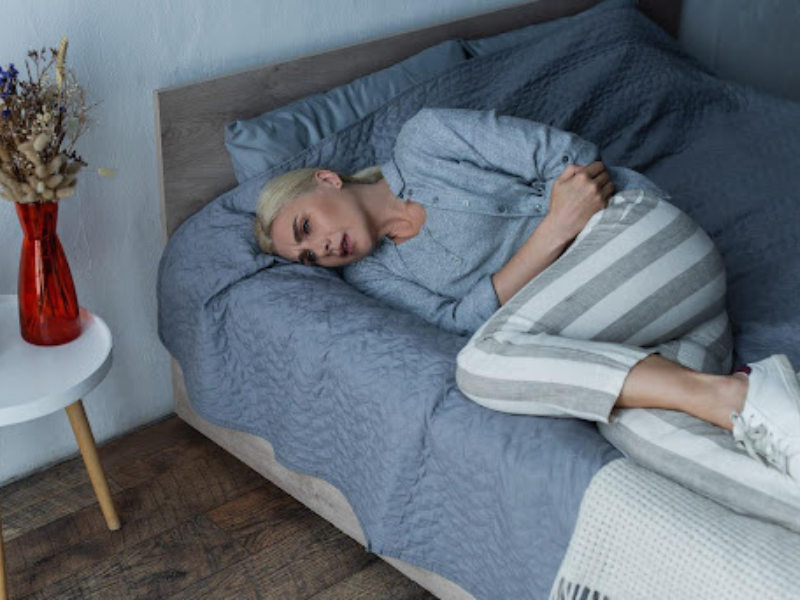
A Guide to Understanding Menopause and Cramps
Menopause welcomes a variety of hormonal fluctuations in a female’s body, including certain symptoms ranging from mild to severe. One of the most common symptoms experienced by women during this transitory phase is cramping. Menopause and cramps go hand-in-hand, these cramps affect different parts of a female’s body including their legs also accompanied by spotting.
Menopause is a natural phenomenon in a woman’s life that brings many changes, including cramps and other discomfort. Comprehending the symptoms and reasons of cramps related to menopause and implementing proactive approaches can help in controlling them. Hence, understanding the symptoms and causes as well as identifying the relief is very essential for every woman.
Menopause and Leg Cramps
The transitional phases trigger menopause and leg cramps in some women, which are mostly categorized by abrupt involuntary contractions in the muscles. The cramps do not have a specific timing they can appear at any point of the day or night, causing disruption in everyday activities as well as sleep.
The specific reason behind the association of menopause and leg cramps has not been fully discovered but it is believed that hormonal transitions, electrolyte imbalances, and reduced circulation have a major role to play in this scenario. Also, to manage these cramps efficiently one must adopt lifestyle changes such as staying hydrated, regular exercising, and sufficient intake of electrolytes such as magnesium and potassium.
Menopause Cramps and Spotting
Menopause cramps and spotting can be a concern for women as this is something that needs to be taken care of. Spotting implies light bleeding that happens outside normal menstrual periods and sometimes coincides with cramping.
While spotting during menopause is benign, it is crucial to discuss it with a healthcare professional in case of abnormal or heavy bleeding to rule out the fundamental causes such as uterine fibroids, hormonal imbalances, or endometrial transitions.
Cramps after Menopause: Are They Normal?
Women don’t expect to experience cramps after menopause as they assume that such discomforts tend to cease once the menstrual cycle has come to an end. These cramps are often associated with fluctuations in the hormonal level or related to aging factors such as nerve activity or muscle functions.
Managing and comprehending post-menopausal cramps often includes a smooth combination of dietary modifications, lifestyle changes, and some medications to eliminate such symptoms and discomfort and have improved quality of life.
Link Between Menopause and Nutrient Deficiency
Menopause cramps might be made worse by nutritional inadequacies in addition to hormonal fluctuations. The body requires more vitamins and minerals, such as calcium, vitamin D, and magnesium, during menopause. These nutrients are essential for the proper operation of muscles, and their deficiency can aggravate cramps.
For example, a lack of magnesium can lead to more frequent cramps, particularly in the legs, as it aids in muscular relaxation. By increasing the intake of these vital minerals through diet or supplements, leg cramps during menopause can frequently be minimized.
The main cause of cramps during menopause is hormonal changes, specifically shifting levels of progesterone and estrogen. Since estrogen is necessary to keep muscles flexible, a decrease in estrogen during menopause can lead to muscle tightening or spasming, especially in the legs and pelvis.
Cramps might happen more frequently as muscles lose their reactivity, particularly in the lower abdomen and legs. Leg cramps and menopausal severity may also worsen as a result of this.
Menopause Cramps: Its Symptoms and Causes
Menopause arrives at the age of 45-55 and it is considered to be the biological declaration of cessation of a female’s menstrual cycle and reproductive years. At this point, hormonal imbalances specifically a decline in estrogen levels lead to various other symptoms such as mood swings, hot flashes, and cramps.
Menopause gets manifested differently for various women from ranging mild to severe pain that can make your everyday activities difficult and give you more and more discomfort. Often these unexpected symptoms lead to anxiety, depression, and other mental disturbances which mark the onset of various other health issues.
Natural Remedies for Menopausal Cramps

Administering menopausal cramps often begins with incorporating healthy lifestyle habits and adopting natural remedies. For women going through this transitory period, they need to understand regular exercising, such as walking, jogging, swimming, and yoga. These healthy practices will ensure enhanced circulation and muscle tone decreasing the frequency and intensity of cramps. In terms of dietary modifications, it is essential to incorporate calcium, magnesium, and food rich in potassium.
These modifications in the diet will bring better bone and muscle health as well as reduce discomfort from cramps. Additionally, there are many available herbal supplements such as black cohosh and evening primrose oil help in eliminating menopausal symptoms including cramps. Acknowledging these practices and adopting them will help in treating all symptoms at the same time. Muscle relaxants can be taken if it’s prescribed by a physician who will understand the current situation of your leg cramps.
Seek Medical Advice
Many women can manage menopausal cramps with their lifestyle transitions as well as natural remedies, yet it is very important to consult a healthcare professional if the discomfort or the cramps persist or get worse. Obstinate cramping especially when followed by heavy bleeding or any uncommon symptoms might require further analysis to rule out the conditions that can impact the overall vaginal and mental health.
Understanding the right strategies and consulting with the healthcare professional will give you better clarity in identifying the causes and symptoms and how severely they can impact your health. For women who have been experiencing chronic menopause cramps antispasmodic medications can help in reducing the involuntary muscle contractions that cause the pain. These medications are taken in case of extreme pain and most certainly under a doctor’s supervision.
The Significance of Regular Checkups
While menopausal cramps can be managed at home, it makes it more essential for you to have checkups at regular intervals especially your gynecological checkups, especially if you notice cramping symptoms or cramps with unusual symptoms.
Healthcare professionals can also perform certain tests to ensure that there are no serious underlying issues like ovarian cysts, uterine fibroids, or any other kind of complications that can affect your health in the long run or cause any exacerbating pain. With regular check-ups, you will always have an idea about your current health condition and adopt the right strategies and medicines to avoid it.
Key Takeaways
In conclusion, managing menopause and cramps includes multifaceted strategies that address both physical symptoms and underlying hormonal transitions. With the appropriate strategy and adequate support, women can efficiently manage menopause and cramps. Every woman must get the symptoms and causes of menopause properly checked by a healthcare professional and identify the potential relief to it. Females can navigate this transitory stage with greater confidence and comfort.
Whether it is through lifestyle changes, medical interventions or natural remedies addressing menopause and cramps can successfully and significantly improve the quality of life during and even beyond menopause. Also, by being mindful of the nutritional deficiencies, bone health, and various other underlying conditions women will be able to manage and rule out the symptoms of menopause and enjoy a better transition into the menopausal life.
Citations

Prativa Chatterjee





